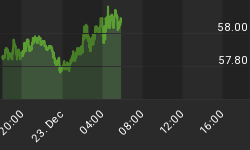Haven't we seen this movie before? The economy enters a recession; we have a bear market, the Fed cuts interest rates drastically flooding the global financial system with cash, and commodity prices begin to soar.
In the United States, the Fed has a handy way to ignore rising commodity prices, something they call core inflation. While most of us eat, drive, and heat our homes, the Fed excludes food and energy from its core inflation reading to remove "volatile" components of the inflation equation.
A March 3 Financial Times article touched on the Fed's current focus in terms of inflation and monetary policy - the key points related to the commodity markets are below:
- Most members of the Fed's rate-setting Federal Open Market Committee have remained steadfast in their preference for looking at core inflation.
- Core consumer prices, excluding food and energy, were up by 1% vs. a year ago in January, while the headline index rose by 1.6%.
- "The Fed remains focused on core inflation at the consumer level, which it thinks will be restrained by high unemployment, and largely dismisses higher food, energy, and commodity prices," said John Ryding, chief economist at RDQ Economics.
The Fed carries our monetary policies, including quantitative easing, by giving freshly printed cash to the network of eighteen primary dealers in exchange for bonds in the dealer's inventory. Since the real world implementation of monetary policy, including QE2, floods the global financial system with cash, it is easy to understand how some of this money finds its way into the global commodity markets. Since we believe the Fed's role in today's asset markets is more significant than even what is perceived by experienced investors, we published a series of articles on Quantitative Easing and Asset Price Inflation in October 2010. Since then, commodity prices have surged. Understanding what QE is and how it works can help you make better investment decisions.
If excess liquidity is making its way through the global financial system, it is helpful to know where the majority of funds are flowing in the commodity complex. Ciovacco Capital's proprietary asset classing ranking models compare 220 different investment options around the globe, across market sectors, and numerous asset classes, including commodities. Using liquid ETFs as a proxy for the underlying commodities, how do commodity investments compare head-to-head in terms of their outlook for the next three-to-twelve months? The table below shows the results for our March 1 rankings.

While we are not out of the correction woods yet relative to the short-term, as we outlined on March 3, we believe the longer-term outlook for risk and inflation-friendly assets, including commodities is postive.
From a fundamental perspective, the primary drivers of these commodity markets are related to increased demand as the global economy expands and the attractiveness as a hedge against the loss of purchasing power caused by "at-the-checkout" inflation. Below are some specifics related to each commodity or investment:
- DBC gives investors exposure to a wide variety of commodities, from zinc to heating oil. With global GDP expected to grow in 2011 and 2012, the demand for commodities should continue to be robust.
- Silver (SLV) is the economically-sensitive precious metal cousin to gold. Silver has more real-world uses than gold, including electrical and chemical applications.
- Agriculture (DBA) can benefit from rising populations and migrations from the lower to middle class, which are becoming more common in Asia as people move from rural areas to cities.
- Gold (GLD) is more attractive than silver when concerns mount related to the economy, geopolitical tensions, and the financial markets. Gold is also attractive to global central bankers and individuals who are concerned about the Fed's overworked printing presses.
- According to the USGS, copper (JJC) is used in building construction, power generation and transmission, electronic product manufacturing, and the production of industrial machinery and transportation vehicles. Copper wiring and plumbing are integral to the appliances, heating and cooling systems, and telecommunications links used every day in homes and businesses. Copper is an essential component in the motors, wiring, radiators, connectors, brakes, and bearings used in cars and trucks.
One of the primary fundamental drivers of the commodity markets is the Fed's loose policies. Ten-month relative strength, where we chart a commodity's performance relative to the S&P 500, is one of the inputs in our asset class ranking system. The ten-month relative strength charts below give us a good visual indication of which markets are benefiting most from QE2 and near-zero interest rates.
















